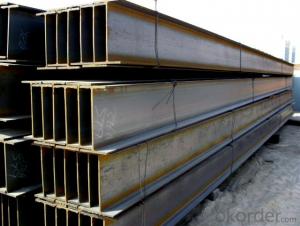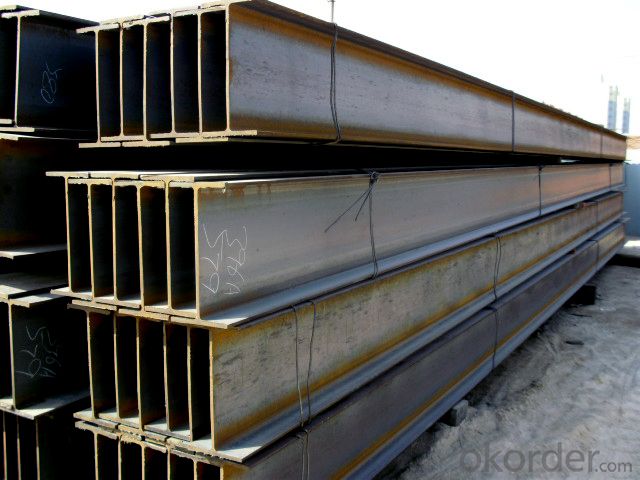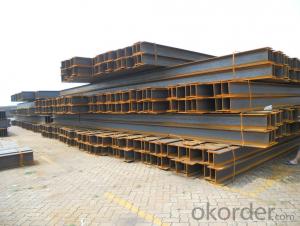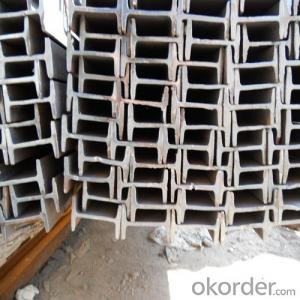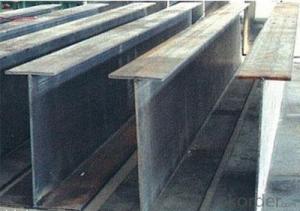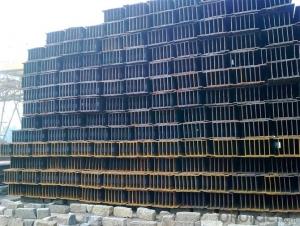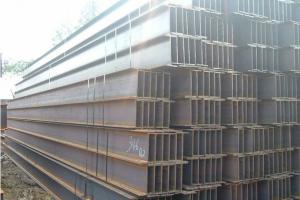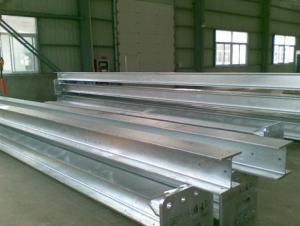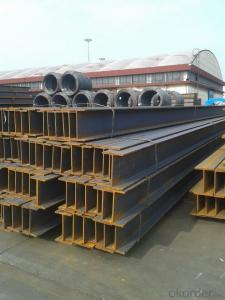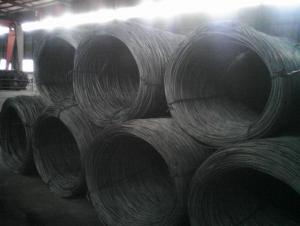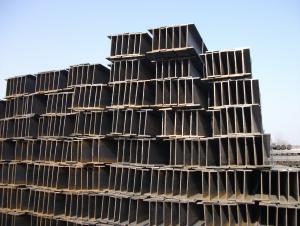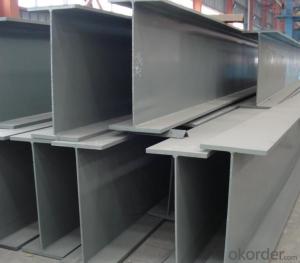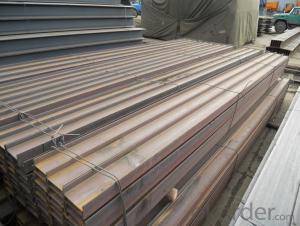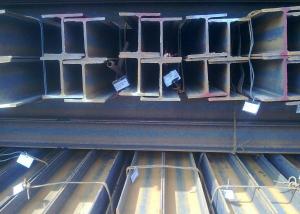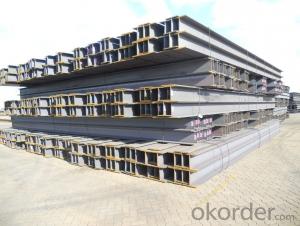Hot Rolled Mild Steel H Beams
- Loading Port:
- China Main Port
- Payment Terms:
- TT or LC
- Min Order Qty:
- 100 m.t.
- Supply Capability:
- 10000 m.t./month
OKorder Service Pledge
OKorder Financial Service
You Might Also Like
Product Description:
OKorder is offering Hot Rolled Mild Steel H Beams at great prices with worldwide shipping. Our supplier is a world-class manufacturer of steel, with our products utilized the world over. OKorder annually supplies products to African, South American and Asian markets. We provide quotations within 24 hours of receiving an inquiry and guarantee competitive prices.
Product Applications:
Hot Rolled Mild Steel H Beams are ideal for structural applications and are widely used inindustrial plants, civil construction, municipal works, oil platforms, bridges, flatbed beams, electrified railway power stand, railway bridges and other light steel structure, super-light H-beam is ideal for containers, mobile homes , all kinds of garage, box-type trains, electrical bracket, various venues, small villa manufacturing etc.
Product Advantages:
OKorder's Hot Rolled Mild Steel H Beams are durable, strong, and wide variety of sizes.
Main Product Features:
· Premium quality
· Prompt delivery & seaworthy packing (30 days after receiving deposit)
· Can be recycled and reused
· Mill test certification
· Professional Service
· Competitive pricing
Product Specifications:
Grade: SS400, Q235
Standard: JIS G3101, GB STANDARD
Payment: T/Tor L/C AT SIGHT
Technique: Hot Rolled
Package: Packed in bundles and shipped by break bulk or containers.
size | Kg/m |
100*100 | 16.9 |
125*125 | 23.6 |
150*75 | 14 |
150*150 | 31.1 |
148*100 | 20.7 |
198*99 | 17.8 |
200*100 | 20.9 |
248*124 | 25.1 |
250*125 | 29 |
FAQ:
Q1: How many tons of steel products could be loaded in containers?
A1: Usually the steel products are delivered by bulk vessel because of the large quantity and the freight. However, there are no bulk vessel enter some seaports so that we have to deliver the cargo by containers. The 6m steel product can be loaded in 20FT container, but the quantity is changed according to the size, usually from 18tons to 25tons.
Q2: what is the difference between actual weight and theoretical weight?
A2: All the section steel has two weights: actual weight and theoretical weight. Actual weight is the weighing out when the product delivered from the mill. Theoretical weight is calculated by pieces. The invoice can be based on each of them as your request.
Q3: How soon can we receive the product after purchase?
A3: Within three days of placing an order, we will arrange production. The normal sizes with the normal grade can be produced within one month. The specific shipping date is dependent upon international and government factors, the delivery to international main port about 45-60days.
Images:
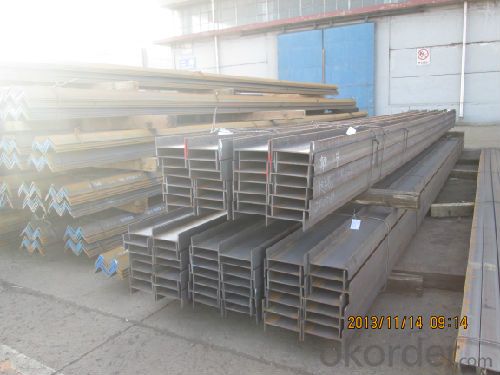
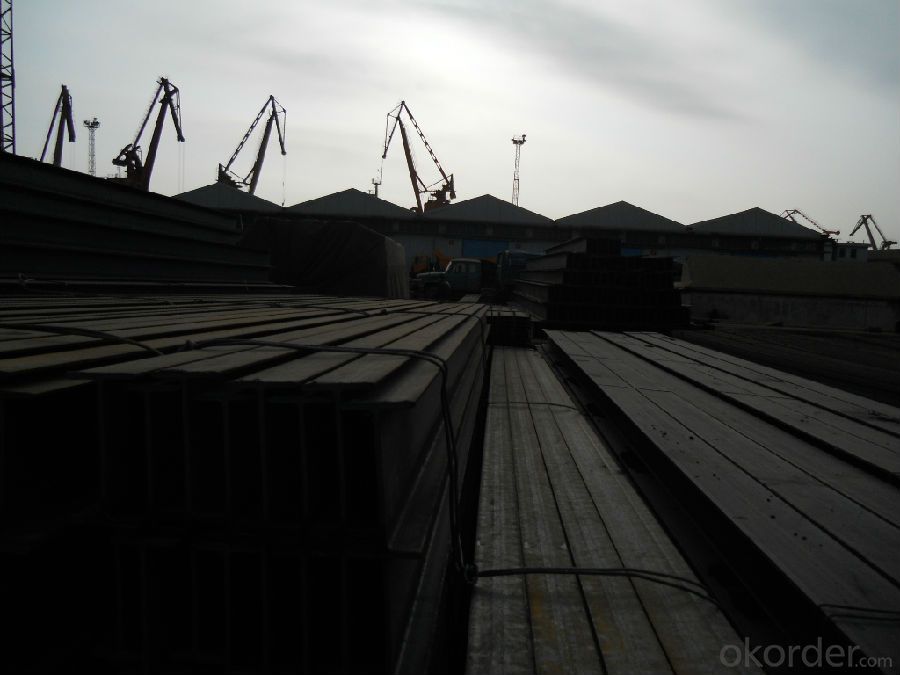
- Q: What are the common sizes of steel H-beams?
- The common sizes of steel H-beams vary depending on the specific needs and requirements of a project. However, there are several standard sizes that are commonly used in construction and engineering applications. Some of the most common sizes include: - W6x9: This size refers to a wide flange beam with a height of 6 inches and a weight per foot of 9 pounds. It is often used in residential construction or smaller structural applications. - W10x33: Another popular size, this wide flange beam has a height of 10 inches and weighs 33 pounds per foot. It is commonly used in commercial construction and larger structural projects. - W12x65: This wide flange beam has a height of 12 inches and weighs 65 pounds per foot. It is often used in heavy-duty construction projects or for supporting larger loads. - W18x76: With a height of 18 inches and a weight per foot of 76 pounds, this wide flange beam is commonly used in industrial applications or for supporting extremely heavy loads. - W36x135: This is one of the largest commonly available sizes of wide flange beams, with a height of 36 inches and weighing 135 pounds per foot. It is typically used in the construction of large-scale structures such as bridges or high-rise buildings. These are just a few examples of the common sizes of steel H-beams. It is important to consult with a structural engineer or reference specific industry standards to determine the appropriate size for a particular project, as the size requirements can vary depending on factors such as load capacity, span length, and structural design.
- Q: How do Steel H-Beams compare in terms of lifespan and durability?
- Steel H-Beams are known for their exceptional lifespan and durability. Due to their robust construction and resistance to corrosion, they can withstand extreme conditions, such as heavy loads and harsh weather, without compromising their structural integrity. This makes them highly durable and suitable for long-term use in various applications, including construction and infrastructure projects.
- Q: Can steel H-beams be used in the construction of railway infrastructure?
- Certainly! Steel H-beams are suitable for the construction of railway infrastructure. Commonly referred to as I-beams or universal beams, these H-beams are widely used in construction due to their structural strength and versatility. They are designed to withstand heavy loads and provide stability, making them appropriate for various applications in railway infrastructure. Railway bridges, tracks, and other supporting structures can all benefit from the utilization of steel H-beams. They are frequently employed as girders to support the weight of railway tracks, ensuring stability and durability. Additionally, H-beams can be utilized in the construction of railway buildings such as stations and platforms. The advantages of using steel H-beams in railway infrastructure construction are numerous. Their high strength-to-weight ratio allows for efficient use of materials while maintaining structural integrity. Corrosion resistance is also a key attribute, particularly for railway infrastructure exposed to harsh weather conditions. Furthermore, steel H-beams can be customized to specific sizes and shapes to meet the requirements of a particular railway project. In summary, steel H-beams are an excellent choice for the construction of railway infrastructure due to their strength, durability, and versatility. They provide the necessary support and stability for railway tracks, bridges, and other structures, ensuring the safe and efficient operation of the railway system.
- Q: What are the common challenges faced during the installation of steel H-beams?
- During the installation of steel H-beams, there are several common challenges that may be encountered. These challenges include: 1. Weight and size: Steel H-beams are usually large and heavy, making them difficult to handle and maneuver during installation. The weight and size of these beams can pose challenges in terms of transportation and positioning on the construction site. 2. Alignment: Achieving proper alignment of H-beams is crucial for structural integrity. It can be challenging to ensure that the beams are perfectly aligned vertically and horizontally, especially when dealing with multiple beams or long spans. 3. Connection methods: H-beams need to be securely connected to other structural elements, such as columns or foundations. Selecting the appropriate connection method and ensuring its proper execution can be a challenge, as it requires specialized knowledge and expertise. 4. Crane and equipment limitations: The installation of steel H-beams often requires the use of cranes and other heavy equipment. However, these equipment have their limitations in terms of lifting capacity, reach, and access to the construction site. Overcoming these limitations can be a challenge, especially in tight or congested areas. 5. Safety considerations: The installation of steel H-beams involves working at height and handling heavy materials. This raises safety concerns for the workers involved. Ensuring proper safety measures, such as fall protection, proper lifting techniques, and adequate training, is critical to mitigate these risks. 6. Site conditions: The condition of the construction site can also present challenges during the installation of steel H-beams. Uneven or unstable ground, restricted access, or adverse weather conditions can all impact the installation process and require additional planning and precautions. To overcome these challenges, it is essential to have a well-coordinated plan, skilled personnel, and proper equipment. Engaging experienced professionals and ensuring effective communication among all parties involved can help address these challenges and ensure a successful installation of steel H-beams.
- Q: Can Steel H-Beams be used in modular or prefabricated construction?
- Yes, Steel H-Beams can be used in modular or prefabricated construction. They provide structural support and can be easily assembled or disassembled, making them suitable for modular construction methods.
- Q: What is the lifespan of a steel H-beam in outdoor applications?
- The lifespan of a steel H-beam in outdoor applications can vary depending on several factors. Firstly, the quality and grade of the steel used in the H-beam will play a significant role in determining its lifespan. Higher quality steels with proper corrosion-resistant coatings can withstand outdoor conditions for a longer period. Secondly, environmental conditions such as exposure to moisture, extreme temperatures, and corrosive elements like saltwater or chemicals can impact the lifespan of the H-beam. Regular maintenance and proper protective measures, such as applying anti-corrosion coatings or galvanization, can significantly extend the lifespan of the H-beam in such environments. Additionally, the load-bearing capacity and structural integrity of the H-beam should be considered to ensure it can withstand any potential stress or external forces it may encounter during its lifespan. Proper design, installation, and regular inspections are crucial to maintaining the structural integrity and longevity of the H-beam in outdoor applications. Overall, it is challenging to provide a specific lifespan for a steel H-beam in outdoor applications, as it depends on various factors as mentioned above. However, with proper material selection, regular maintenance, and protective measures, a steel H-beam can last for several decades in outdoor applications.
- Q: Can steel H-beams be used in mezzanine floors?
- Indeed, mezzanine floors can incorporate steel H-beams. Owing to their robustness and longevity, steel H-beams find widespread application in the construction industry. They offer exceptional reinforcement and can endure substantial loads, rendering them ideal for mezzanine floors that serve as intermediary levels within a building. Steel H-beams enable the creation of a sturdy and secure framework for a mezzanine floor, thus enabling the provision of extra space and storage capacity within a structure.
- Q: How do steel H-beams perform in coastal or saltwater environments?
- Steel H-beams exhibit satisfactory performance in coastal or saltwater settings, yet they necessitate appropriate upkeep and protective measures to avert corrosion. The presence of saltwater and high humidity in coastal regions engenders a corrosive atmosphere that can hasten steel degradation. Regardless, steel H-beams are widely utilized in coastal construction ventures due to their robustness, longevity, and cost-effectiveness. To guarantee their effectiveness and endurance in such environments, several factors must be taken into consideration. Firstly, the application of corrosion-resistant coatings is imperative. The utilization of coatings like epoxy, zinc, or galvanization can substantially heighten the steel's resistance to saltwater corrosion. These coatings serve as a barrier between the steel and the corrosive environment, hindering direct contact and impeding the oxidation process. Regular inspections and maintenance are equally vital in coastal or saltwater areas. It is necessary to thoroughly examine the H-beams for any signs of corrosion, such as rust or pitting, in order to identify and address any initial stages of deterioration. Any damaged or compromised protective coatings should be promptly repaired or replaced to prevent further corrosion. Moreover, appropriate drainage and ventilation systems should be established to minimize the accumulation of saltwater and moisture on the steel surfaces. Excessive moisture or prolonged exposure to saltwater can expedite the corrosion process, resulting in structural integrity concerns. Sufficient ventilation allows for air circulation, reducing the likelihood of moisture buildup and providing a more favorable environment for the steel. It should be noted that the performance of steel H-beams in coastal or saltwater environments is contingent upon the specific grade and quality of steel utilized. Opting for high-quality corrosion-resistant steel, such as stainless steel or weathering steel, can furnish augmented protection against saltwater corrosion. In conclusion, although steel H-beams can deliver satisfactory performance in coastal or saltwater environments, it is vital to implement proper upkeep and protective measures. The utilization of corrosion-resistant coatings, regular inspections, establishment of proper drainage and ventilation systems, and selection of high-quality steel can all contribute to their long-term performance and durability in these challenging environments.
- Q: How do steel H-beams perform in areas with high humidity and moisture?
- Steel H-beams perform well in areas with high humidity and moisture due to their inherent durability and resistance to corrosion. The steel used in H-beams is typically coated with protective finishes such as galvanization or paint, further enhancing their resistance to moisture-related damage. This ensures that they maintain their structural integrity and strength even in challenging environments.
- Q: Can steel H-beams be used in the construction of medical facilities or hospitals?
- Yes, steel H-beams can be used in the construction of medical facilities or hospitals. Steel H-beams are commonly used in construction due to their strength and durability, making them suitable for supporting the structural load of buildings, including medical facilities.
Send your message to us
Hot Rolled Mild Steel H Beams
- Loading Port:
- China Main Port
- Payment Terms:
- TT or LC
- Min Order Qty:
- 100 m.t.
- Supply Capability:
- 10000 m.t./month
OKorder Service Pledge
OKorder Financial Service
Similar products
Hot products
Hot Searches
Related keywords
